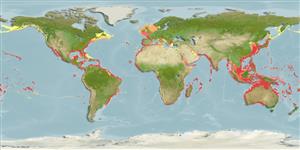Common names from other countries
>
Carangiformes (Jacks) >
Echeneidae (Remoras)
Etymology: Remora: Latin, remora = delay, hindrance (1567) (Ref. 45335); remora: remora meaning delay or hindrance; these fish were once thought to delay a ship's progress when they attached to the hull (Ref. 4389).
More on author: Linnaeus.
Environment: milieu / climate zone / depth range / distribution range
Écologie
marin récifal; profondeur 0 - 200 m (Ref. 86942). Subtropical; 60°N - 36°S, 180°W - 180°E
Cosmopolitan in warm waters.
Taille / Poids / Âge
Maturity: Lm ? range ? - ? cm
Max length : 86.4 cm TL mâle / non sexé; (Ref. 26340); common length : 40.0 cm TL mâle / non sexé; (Ref. 26999); poids max. publié: 1.1 kg (Ref. 40637)
Épines dorsales (Total) : 0; Rayons mous dorsaux (Total) : 22 - 26; Épines anales: 0; Rayons mous anaux: 22 - 24. Dark brownish grey in color (Ref. 4389). During the course of development, fin is transformed into a suction disc (Ref. 35388). Deeper-bodied than Echeneis naucrates (Ref. 37816).
Usually associated with sharks but also attaches itself to other large fishes, sea turtles and even ships (Ref. 2850, 58302); found in gill chambers, fins and body surface (Ref. 5951). Sometimes free-swimming (Ref. 2850). Younger individual is more active as parasite pickers (Ref. 26938). Feeds on parasitic copepods (Ref. 35388).
Life cycle and mating behavior
Maturities | Reproduction | Spawnings | Egg(s) | Fecundities | Larves
Lachner, E.A. and A. Post, 1990. Echeneidae. p. 725-728. In J. C. Quéro, J. C. Hureau, C. Karrer, A. Post and L. Saldanha (eds.) Check-list of the fishes of the eastern tropical Atlantic (CLOFETA). JNICT, Lisbon; SEI, Paris; and UNESCO, Paris. Vol. 2. (Ref. 10791)
Statut dans la liste rouge de l'IUCN (Ref. 130435)
CITES (Ref. 128078)
Not Evaluated
Menace pour l'homme
Harmless
Utilisations par l'homme
Pêcheries: commercial
Outils
Articles particuliers
Télécharger en XML
Sources Internet
Estimates based on models
Preferred temperature (Ref.
115969): 11.7 - 28.2, mean 24.8 (based on 2107 cells).
Phylogenetic diversity index (Ref.
82804): PD
50 = 0.5352 [Uniqueness, from 0.5 = low to 2.0 = high].
Bayesian length-weight: a=0.00263 (0.00112 - 0.00620), b=3.17 (2.96 - 3.38), in cm Total Length, based on LWR estimates for this (Sub)family-body shape (Ref.
93245).
Niveau trophique (Ref.
69278): 3.5 ±0.4 se; based on diet studies.
Résilience (Ref.
120179): Milieu, temps minimum de doublement de population : 1,4 à 4,4 années (Assuming Fec < 10,000).
Fishing Vulnerability (Ref.
59153): Moderate to high vulnerability (55 of 100).
